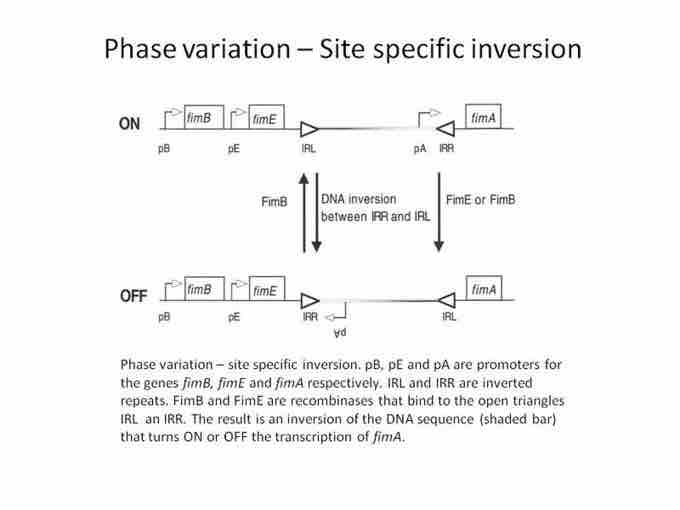Recombining sequences in site-specific reactions are usually short and occur at a single target site within the recombining sequence. For this to occur, there is typically one or more cofactors (to name a few: DNA-binding proteins and the presence or absence of DNA binding sites) and a site specific recombinase. There is also a change in orientation of the DNA that will affect gene expression or the structure of the gene product. This is done by changing the spatial arrangement of the promoter or the regulatory elements.
Through the utilization of specific recombinases, a particular DNA sequence is inverted, resulting in an ON to OFF switch, and vice versa, of the gene located within or next to this switch. Many bacterial species can utilize inversion to change the expression of certain genes for the benefit of the bacterium during infection . The inversion event can be simple by involving the toggle in expression of one gene, like E. coli pilin expression; or more complicated by involving multiple genes in the expression of multiple types of flagellin by S. typhimurium. Fimbrial adhesion by the type I fimbriae in E. coli undergoes site specific inversion to regulate the expression of fimA, the major subunit of the pili, depending on the stage of infection. The invertible element has a promoter within it that depending on the orientation will turn on or off the transcription of fimA. The inversion is mediated by two recombinases, FimB and FimE, and regulatory proteins H-NS, Integration Host Factor (IHF) and Leucine responsive protein (LRP). The FimE recombinase has the capability to only invert the element and turn expression from on to off, while FimB can mediate the inversion in both directions.

Phase variation Site specific Inversion
Phase and Antigenic Variation in Bacteria. pA is the promoter for FimA, pB is the promoter for FimB and pE is the promoter for FimE. IRR is inverted repeat right and IRL is inverted repeat left. FimB and FimE are recombinases that can change the orientation of the FimA promoter by inverting the IRR and IRL.